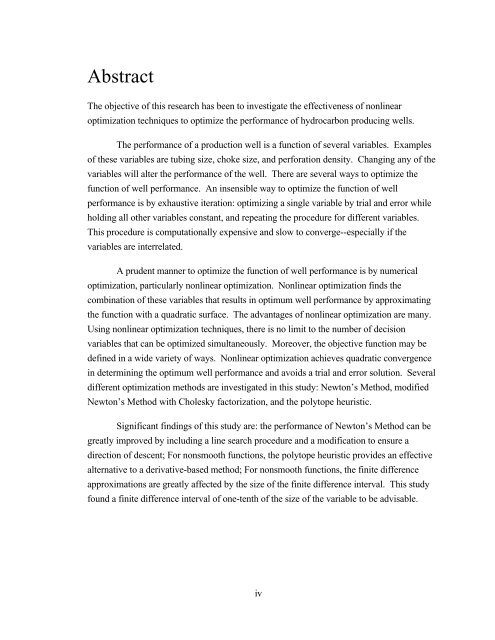multivariate production systems optimization - Stanford University
multivariate production systems optimization - Stanford University
multivariate production systems optimization - Stanford University
Create successful ePaper yourself
Turn your PDF publications into a flip-book with our unique Google optimized e-Paper software.
Abstract<br />
The objective of this research has been to investigate the effectiveness of nonlinear<br />
<strong>optimization</strong> techniques to optimize the performance of hydrocarbon producing wells.<br />
The performance of a <strong>production</strong> well is a function of several variables. Examples<br />
of these variables are tubing size, choke size, and perforation density. Changing any of the<br />
variables will alter the performance of the well. There are several ways to optimize the<br />
function of well performance. An insensible way to optimize the function of well<br />
performance is by exhaustive iteration: optimizing a single variable by trial and error while<br />
holding all other variables constant, and repeating the procedure for different variables.<br />
This procedure is computationally expensive and slow to converge--especially if the<br />
variables are interrelated.<br />
A prudent manner to optimize the function of well performance is by numerical<br />
<strong>optimization</strong>, particularly nonlinear <strong>optimization</strong>. Nonlinear <strong>optimization</strong> finds the<br />
combination of these variables that results in optimum well performance by approximating<br />
the function with a quadratic surface. The advantages of nonlinear <strong>optimization</strong> are many.<br />
Using nonlinear <strong>optimization</strong> techniques, there is no limit to the number of decision<br />
variables that can be optimized simultaneously. Moreover, the objective function may be<br />
defined in a wide variety of ways. Nonlinear <strong>optimization</strong> achieves quadratic convergence<br />
in determining the optimum well performance and avoids a trial and error solution. Several<br />
different <strong>optimization</strong> methods are investigated in this study: Newton’s Method, modified<br />
Newton’s Method with Cholesky factorization, and the polytope heuristic.<br />
Significant findings of this study are: the performance of Newton’s Method can be<br />
greatly improved by including a line search procedure and a modification to ensure a<br />
direction of descent; For nonsmooth functions, the polytope heuristic provides an effective<br />
alternative to a derivative-based method; For nonsmooth functions, the finite difference<br />
approximations are greatly affected by the size of the finite difference interval. This study<br />
found a finite difference interval of one-tenth of the size of the variable to be advisable.<br />
iv

















